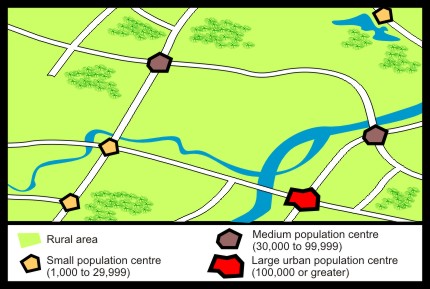Rural area (RA)
Archived Content
Information identified as archived is provided for reference, research or recordkeeping purposes. It is not subject to the Government of Canada Web Standards and has not been altered or updated since it was archived. Please "contact us" to request a format other than those available.
Detailed definition
Rural areas (RAs) include all territory lying outside population centres (POPCTRs). Taken together, population centres and rural areas cover all of Canada.
Rural population includes all population living in rural areas of census metropolitan areas (CMAs) and census agglomerations (CAs), as well as population living in rural areas outside CMAs and CAs.

Censuses
2011, 2006, 2001, 1996, 1991, 1986, 1981, 1976, 1971, 1966, 1961
Remarks
The rural area of Canada is the area that remains after the delineation of population centres using current census population data.
Within rural areas, population densities and living conditions can vary greatly. Included in rural areas are:
- small towns, villages and other populated places with less than 1,000 population according to the current census
- rural areas of census metropolitan areas and census agglomerations that may contain estate lots, as well as agricultural, undeveloped and non-developable lands
- agricultural lands
- remote and wilderness areas.
Refer to the related definitions of census metropolitan area (CMA) and census agglomeration (CA); core, fringe and rural area; designated place (DPL); population centre (POPCTR) and population density.
Changes prior to the current census
Prior to 2011, rural areas were the residual after the delineation of urban areas (now called population centres).
Prior to 2001, rural areas were the residual after the delineation of urban areas that was based on population data from the previous census.
- Date modified:
